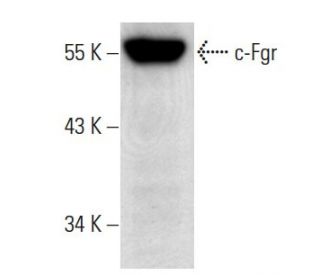

c-Fgr Antibody (D-6): sc-74542
- c-Fgr Antibody (D-6) is a mouse monoclonal IgG2b κ, cited in 5 publications, provided at 200 µg/ml
- raised against amino acids 4-63 mapping at the N-terminus of c-Fgr of mouse origin
- c-Fgr Antibody (D-6) is recommended for detection of c-Fgr p55 of mouse origin by WB, IP, IF and ELISA
- Anti-c-Fgr Antibody (D-6) is available conjugated to agarose for IP; HRP for WB, IHC(P) and ELISA; and to either phycoerythrin or FITC for IF, IHC(P) and FCM
- also available conjugated to Alexa Fluor® 488, Alexa Fluor® 546, Alexa Fluor® 594 or Alexa Fluor® 647 for WB (RGB), IF, IHC(P) and FCM, and for use with RGB fluorescent imaging systems, such as iBright™ FL1000, FluorChem™, Typhoon, Azure and other comparable systems
- also available conjugated to Alexa Fluor® 680 or Alexa Fluor® 790 for WB (NIR), IF and FCM; for use with Near-Infrared (NIR) detection systems, such as LI-COR®Odyssey®, iBright™ FL1000, FluorChem™, Typhoon, Azure and other comparable systems
- m-IgG Fc BP-HRP and m-IgG2b BP-HRP are the preferred secondary detection reagents for c-Fgr Antibody (D-6) for WB applications. These reagents are now offered in bundles with c-Fgr Antibody (D-6) (see ordering information below).
QUICK LINKS
SEE ALSO...
c-Fgr Antibody (D-6) is a mouse monoclonal IgG2b kappa light chain antibody that detects c-Fgr p55 of mouse origin by western blotting (WB), immunoprecipitation (IP), immunofluorescence (IF), and enzyme-linked immunosorbent assay (ELISA). c-Fgr (D-6) antibody is available in non-conjugated and various conjugated forms, including agarose, horseradish peroxidase (HRP), phycoerythrin (PE), fluorescein isothiocyanate (FITC), and multiple Alexa Fluor® conjugates. c-Fgr, a member of the Src family of non-receptor tyrosine kinases, plays a crucial role in cellular signaling pathways that regulate essential processes such as cell proliferation, differentiation, and motility. c-Fgr primarily resides in the cytoplasm and can move to the cell membrane, becoming activated in response to various stimuli. This localization to different cellular compartments enables precise regulation of signaling cascades that influence cellular responses to external signals. The human c-Fgr gene encodes a 529 amino acid protein, with tightly controlled activity to prevent aberrant signaling that could lead to oncogenesis. Understanding c-Fgr localization and function remains essential for elucidating its role in health and disease, particularly in cancer research, where Src family kinases are often implicated in tumor progression and metastasis.
Alexa Fluor® is a trademark of Molecular Probes Inc., OR., USA
LI-COR® and Odyssey® are registered trademarks of LI-COR Biosciences
c-Fgr Antibody (D-6) References:
- Kinases of the Src family: structure and functions. | Tatosyan, AG. and Mizenina, OA. 2000. Biochemistry (Mosc). 65: 49-58. PMID: 10702640
- Src kinase-mediated signaling in leukocytes. | Korade-Mirnics, Z. and Corey, SJ. 2000. J Leukoc Biol. 68: 603-13. PMID: 11073097
- Selected glimpses into the activation and function of Src kinase. | Bjorge, JD., et al. 2000. Oncogene. 19: 5620-35. PMID: 11114743
- SRC family kinases mediate epithelial Na+ channel inhibition by endothelin. | Gilmore, ES., et al. 2001. J Biol Chem. 276: 42610-7. PMID: 11560932
- Regulation of c-fgr messenger RNA levels in U937 cells treated with different modulating agents. | Faulkner, L., et al. 1992. Immunology. 76: 65-71. PMID: 1628903
- The c-fgr proto-oncogene: expression in Epstein-Barr-virus-infected B lymphocytes and in cells of the myelomonocytic and granulocytic lineages. | Patel, M., et al. 1991. Pathobiology. 59: 289-92. PMID: 1652975
- The level of c-fgr RNA is increased by EBNA-2, an Epstein-Barr virus gene required for B-cell immortalization. | Knutson, JC. 1990. J Virol. 64: 2530-6. PMID: 2159528
- Structure and expression of c-fgr protooncogene mRNA in Epstein-Barr virus converted cell lines. | Brickell, PM. and Patel, M. 1988. Br J Cancer. 58: 704-9. PMID: 2852026
- Isolation and chromosomal localization of the human fgr protooncogene, a distinct member of the tyrosine kinase gene family. | Tronick, SR., et al. 1985. Proc Natl Acad Sci U S A. 82: 6595-9. PMID: 2995972
- Regulation of c-Fgr protein kinase by c-Src kinase (CSK) and by polycationic effectors. | Ruzzene, M., et al. 1994. J Biol Chem. 269: 15885-91. PMID: 7515063
- Specific stimulation of c-Fgr kinase by tyrosine-phosphorylated (poly)peptides--possible implication in the sequential mode of protein phosphorylation. | Ruzzene, M., et al. 1997. Eur J Biochem. 245: 701-7. PMID: 9183008
- Insights into Src kinase functions: structural comparisons. | Williams, JC., et al. 1998. Trends Biochem Sci. 23: 179-84. PMID: 9612082
Ordering Information
| Product Name | Catalog # | UNIT | Price | Qty | FAVORITES | |
c-Fgr Antibody (D-6) | sc-74542 | 200 µg/ml | $316.00 | |||
c-Fgr Antibody (D-6): m-IgG Fc BP-HRP Bundle | sc-525727 | 200 µg Ab; 10 µg BP | $354.00 | |||
c-Fgr Antibody (D-6): m-IgG2b BP-HRP Bundle | sc-549631 | 200 µg Ab; 10 µg BP | $354.00 | |||
c-Fgr Antibody (D-6) AC | sc-74542 AC | 500 µg/ml, 25% agarose | $416.00 | |||
c-Fgr Antibody (D-6) HRP | sc-74542 HRP | 200 µg/ml | $316.00 | |||
c-Fgr Antibody (D-6) FITC | sc-74542 FITC | 200 µg/ml | $330.00 | |||
c-Fgr Antibody (D-6) PE | sc-74542 PE | 200 µg/ml | $343.00 | |||
c-Fgr Antibody (D-6) Alexa Fluor® 488 | sc-74542 AF488 | 200 µg/ml | $357.00 | |||
c-Fgr Antibody (D-6) Alexa Fluor® 546 | sc-74542 AF546 | 200 µg/ml | $357.00 | |||
c-Fgr Antibody (D-6) Alexa Fluor® 594 | sc-74542 AF594 | 200 µg/ml | $357.00 | |||
c-Fgr Antibody (D-6) Alexa Fluor® 647 | sc-74542 AF647 | 200 µg/ml | $357.00 | |||
c-Fgr Antibody (D-6) Alexa Fluor® 680 | sc-74542 AF680 | 200 µg/ml | $357.00 | |||
c-Fgr Antibody (D-6) Alexa Fluor® 790 | sc-74542 AF790 | 200 µg/ml | $357.00 |
